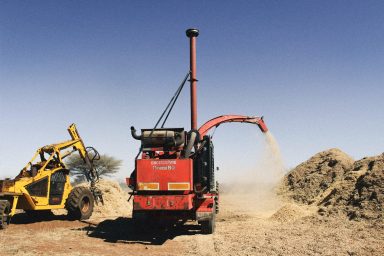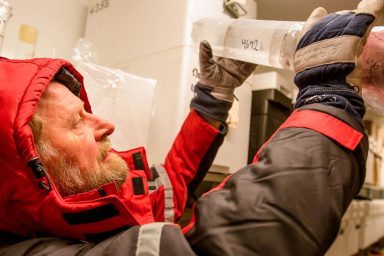“Get the frack out,” say protesters to oil and gas companies that have drilled more than 100 wells near their homes in Erie, CO. State officials may finally be listening to complaints about airborne chemicals.
In what has become an exhausting routine over the past several months, Sandra Duggan and her husband, Eric, readied their remarks, stated their names and address for the record, and delivered a plea to the Board of Trustees in Erie, CO, to protect their health from fracking sites so close to their home that vibrations knock framed pictures from the walls.
On May 11, the Duggans urged the board to approve the installation of air-monitoring equipment to track in real time what people in Erie, 25 miles north of Denver, breathe every day.
“We deserve to know what is in our air,” Eric Duggan said at the meeting. “Arm yourselves with the tools to make future decisions about oil and gas development, and advocate for our health and safety.”
Some 117 producing wells dot the town of Erie. The Duggans first noticed Mae J, a fracking pad hosting 12 wells a half-mile down the road from their place, when sound barriers more than 20 feet high went up around the site at the beginning of the year. Papa Jo and Yellowhammer, two pads flanking Mae J, add another 16 wells. Some of the Duggans’s neighbors live less than 500 feet from the sites.
“The noise is unbearable, particularly during the fracking and then during the coiling and tubing stages of the process,” said Sandra. “[The frackers] like to work in the middle of the night.”
Disturbances at late hours add to other health concerns. Sandra’s migraines worsened drastically once nearby fracking started, and outdoor activities like yard work often cause a burning throat and coughing fits. Her neighbors have reported everything from dizziness and headaches to nosebleeds and asthma flares.
“No cancers yet. But physical symptoms,” said Kelsey Barnholt, one of those neighbors.
A 2019 study commissioned by Colorado’s public health department to look at chemical exposure near fracking sites validated residents’ symptoms. At 500 feet from well sites, one hour of exposure to benzene and toluene in the air was 10 times higher than the levels federal guidelines suggest are safe for human health. Concentrations remained several times higher than those thresholds even 2,000 feet out.
Environmental and health impacts of the 1,084 additives the US Environmental Protection Agency catalogs are often not known, and oil companies can legally hide the ingredients in their fracking fluid by claiming they’re a trade secret.
The study concluded that long-term exposure to fracking emissions was in most cases not hazardous, but didn’t rule out chronic health impacts, because it didn’t measure “chronic exposures representative of what happens in areas with multiple well pads.”
Emissions are highest during flowback, when the chemicals and sand, added to water and pumped under high pressure to crack shale in horizontal bore holes, gush back to the surface to make way for oil and gas extraction.
Environmental and health impacts of the 1,084 additives the US Environmental Protection Agency catalogs are often not known, and oil companies can legally hide the ingredients in their fracking fluid by claiming they’re a trade secret. Occidental, the largest well operator in Colorado, selectively identified six additives to Erie residents and highlighted that they’re also found in common household items such as table salt, ice cream, cosmetics, deodorant, and cleaning supplies like bleach. The national chemical disclosure registry FracFocus, however, shows that the company’s fracking fluids contain a host of other, less wholesome ingredients, including carcinogens like benzene.
“It’s really toxic,” said Sandra Duggan. “That’s the primary concern that we all have: To what extent are we being poisoned, and why isn’t anybody doing anything about it?”
Sandra and Eric Duggan were two of more than 200 signatories to a petition urging the Erie Board of Trustees to pass two resolutions on the agenda at the meeting last month. The board voted to pass both: one to contract with Boulder A.I.R., and another to contract with Ajax Analytics and Colorado State University. Both groups would help monitor air quality.
“I think our residents have made clear that they want, need, and are more than ready for and desire this real-time monitoring that they have access to,” said Trustee Sara Loflin during the meeting. “I think it’s frankly the right thing to do in terms of protecting our residents’ health, safety, and welfare.”
Trustee Christiaan van Woudenberg added that it’s “really important for us to start to take responsibility and to not only take the money from oil and gas but to start using those revenues if and when they come to properly be protective of the health and safety and welfare of [our] residents.”
The plan now is to install 10 photo ionization detectors (PIDs) around town. Those sensors respond to spikes in volatile organic compounds, triggering a canister that collects samples if a gas plume wafts by. Colorado State University would analyze the contents of the canister, and Boulder A.I.R. would set up a single site for continuous air-quality monitoring and provide live updates online every five minutes. The board expects the project to be up and running by the end of the summer.
Right away, the PID sensors and Boulder A.I.R. site would warn residents to head indoors in case of an emissions spike. In the long run, Erie residents hope the system will produce enough data to tie their health symptoms to a particular source, including oil and gas operations.
Four other municipalities near the 2,000-square-mile Wattenberg gas field, where much of the state’s oil and gas activity is concentrated, already use similar setups. Erie’s addition will offer one more data set, aiding a growing network of communities whose residents want to know what’s in their air.
Regulatory Turbulence
Erie’s upcoming project is occurring just as the entire state of Colorado is scrambling to get its air quality under control. In 2019, newly elected Governor Jared Polis (D) answered calls for increased oversight of oil and gas and signed bill SB 181, sending shockwaves through state regulatory bodies.
The bill directed state agencies to tighten the protection of public health from oil and gas activities. New rules increased the distance allowed between homes and well pads to 2,000 feet, the strictest for any oil-producing state, but subject to exemptions; granted towns and counties more local control over drilling regulations; and required oil and gas operators to monitor their emissions continuously.
The bill also overhauled the Colorado Oil and Gas Conservation Commission (COGCC), a division of the state’s Department of Natural Resources, and redefined its long-standing mission: Going forward, the commission is meant to regulate the oil industry to ensure public health — completely new territory for an agency whose institutional structure had been built and solidified around fostering oil activities.
“That’s when the world really changed in Colorado,” said Jim Crompton, professor of practice in the Oil Engineering Department of the Colorado School of Mines. “New commissioner, new board, new mission — they’re trying to figure out what they’re supposed to be doing. I’m sure that’s true at all the other agencies. There isn’t just one agency in charge of all of this stuff.”

Weld County, CO, allows fracking just 500 feet from houses. Photo credit: WildEarth Guardians / Flickr (CC BY-NC-ND 2.0)
Erie put a temporary moratorium on processing new permits for oil and gas operations until the rules initiated by SB 181 were finalized. COVID-19 delayed the process throughout last year, but the rules finally went into effect on January 15, 2021.
Although the new regulations have been hailed as some of the most stringent and progressive in the country, residents in Erie see a glaring shortcoming: Oil wells approved before January 15 are exempt from the protections offered by SB 181. Those drill permits were issued legally and in accordance with pre-2021 state law.
“Hundreds,” said Sandra Duggan. “Hundreds that will be exempt because they’re grandfathered in.”
She is underestimating. COGCC records list more than a thousand wells approved for drilling in the six months before January 15. Occidental received its permit for Mae J in 2017 but only this year got around to drilling and fracking its wells.
Meanwhile, complaints from residents to regulatory agencies haven’t gained much traction. The COGCC received more than 3,400 complaints statewide about noise, odor, and spills during the last five years but found operators violating state or local laws in only 0.83 percent of cases.
The Colorado Department of Public Health and Environment (CDPHE) launched two community investigations in 2018, taking four air samples in Erie neighborhoods. It found no excess level of volatile organic compounds but acknowledged that the small sample size limited the results’ accuracy.
“What we learned after many, many months of fighting this is not that there’s necessarily an unwillingness to act, but there’s no procedures in place to act. There’s no procedures or any kind of path to enforcement on the COGCC side,” said Sandra Duggan.
Institutional confusion is compounded by Erie’s jurisdictional complexity. The town sits in two counties, Boulder and Weld, which couldn’t be more different in their stance toward oil activities.

Drone view of fracking site in Erie, CO. The well is being prepared to produce oil after being fracked. It’s still cordoned off by barriers against sound and light. Photo credit: Courtesy of Erie residents for WhoWhatWhy
While Boulder County was quick to use the authority granted by SB 181 to require a 2,500-foot setback from homes, schools, and daycare centers, Weld County stuck with its 500-foot norm. Mae J, Yellow Hammer, and Papa Jo are in unincorporated Weld County and therefore subject to its rules and outside Erie’s reach.
The oil and gas sector is a powerful economic force in Weld County in particular. Close to 90 percent of Colorado’s crude oil is produced within its borders, and its upstream and midstream operations — extracting crude oil and storing, transporting, and marketing it — employ 37 times as many people as they do in Boulder County.
“There are a lot of people who work for oil and gas or support oil and gas and are outspoken about that,” Sandra Duggan pointed out. “So that’s been a struggle. On top of that some people fear for their jobs. Advocates have even lost their jobs for being vocal against oil and gas. It’s definitely an uphill battle to try and get people involved.”
The Facebook group Erie Protectors informs more than 800 followers about oil and gas activities in the neighborhood, but at town hall meetings, the Duggans and Barnholt are among the handful of residents who persistently speak out.
“It feels like we’re fighting this battle alone,” said Barnholt. “This was not something I wanted to sign up for. But I can’t turn the other way now that I know what I know. It’s super hard to pull people along because no one wants to rise up.”
Sandra Duggan agreed. “It’s really daunting to go up against big oil.”

Protesters rally against fracking in Erie, CO, in June 2012. Many citizens are still unhappy with the noise caused by fracking and the chemicals released. Photo credit: Erie Rising / Flickr (CC BY 2.0)
An Evolution in Oversight
SB 181 has kicked off an evolution in industry oversight, and Erie is struggling to adapt.
As of last month, oil and gas operators in Colorado are required to continuously monitor the air quality around their well sites, starting 10 days ahead of any drilling and lasting six months into oil production. The results go to the Air Pollution Control Division every month.
Operators design their own monitoring plans that state agencies and affected communities review when issuing drill permits. It’s up to operators which equipment to use and which emissions to monitor, depending on whether methane, ozone precursors, or volatile organic compounds are the primary cause of concern at their site.
The objective, the state’s Air Quality Control Commission says, is to “detect, evaluate, and reduce as necessary” emissions from oil and gas. It’s a new concept for both industry and regulators, and prompts questions from all sides about the best way to measure what’s in the air.
“[The new regulation] is largely setting out new expectations about reporting without saying how to report,” said Jim Crompton, a fellow at the Colorado School of Mines Payne Institute for Public Policy. “In a sense it’s almost ahead of the technology. Or certainly it’s ahead of the normal operation practices of the operators to gather that information. Which is why people are scrambling right now.”
The CDPHE, parent of the Air Pollution Control Division, recognized that allowing an industry to self-report its emissions raises red flags.
“It’s something I know always comes up as a question: Is industry kind of monitoring themselves at this point?” said Gordon Pierce, manager of the CDPHE’s technical services program, at a panel discussion last month. “And there’s valid concerns there.”

The Mae J pad and its 12 wells sit just outside Erie’s jurisdictional reach in unincorporated Weld County. Photo credit: Courtesy of Erie residents for WhoWhatWhy
At the moment, the CDPHE has no plans to ask for third-party verification of the data it’s handed, although some smaller oil companies are already looking for independent outside analysis.
Project Canary, a contractor that runs monitoring services for oil operators, works with the Payne Institute to focus a second set of eyes on the information their sensors pick up. The goal is to detect leaks more accurately, speed up real-time analysis, and give operators better information for their monthly reports.
All of this raises a question in Crompton’s mind: “Does the technology really work as it says it’s supposed to?” Another issue, he said, is trust. “We’ll call it maybe certification. When you fill out one of these reports, is it right? Did you cheat, or did you have your thumb on the sensor?”
The Payne Institute is in its first year of providing this kind of certification in partnership with Project Canary and hopes to expand it. Meanwhile, the CDPHE is struggling with a longtime lack of funds and resources.
“With all that’s going on as far as oil and gas development in Colorado, we don’t have the staffing to even hope to monitor everything,” said Pierce. “It’s a hard one. In an ideal world we would have a lot more staffing and we’d be able to get out to a lot of these sites and do more … audits on them ourselves. We’re just not there at this point in time.”
A spokesperson for CDPHE confirmed that there is only one staffer in charge of reviewing the monitoring plans that operators submit, although the team is likely to expand as more data comes in. As of last month, the Air Pollution Control Division had received 37 monitoring plans. “Six months ago, the way the oil and gas industry was, we weren’t expecting much,” Pierce said, “and it’s really picked up.”
“They’ve never had a huge number of staff, and they get pulled in a lot of different directions,” said Jeff Collett, head of the atmospheric sciences department at Colorado State University, who also works on community-focused monitoring projects in Broomfield, 10 miles south of Erie. “They do a good job, but they don’t have the time that, say, an academic team might have to dig into things.”

An Extraction Oil and Gas site in Weld County, CO. Close to 90 percent of Colorado’s crude oil is produced within the county’s borders. Photo credit: WildEarth Guardians / Flickr (CC BY-NC-ND 2.0)
The PID sensors proposed by oil and gas companies register the total concentration of volatile organic compounds, but they can’t tell which chemical species are wafting through the air and in what proportions.
“Without some speciation it’s hard to know what are the health effects of this,” said Collett. “You can miss potentially important things with this PID technology. But I would say most of the time close to the pad the PID does a pretty good job picking up things that are likely to be of biggest concern from a health perspective.”
“Is it confusing? It is very confusing,” Crompton commented. “If I was someone sitting in these areas wondering what’s going on, it would have to be troubling, because there’s an awful lot that is experimental, a lot that’s emerging with the technology. It’s emerging with the regulations. The industry will catch up, but right now no one really knows the best way.”
“My crystal ball is broken,” he added, “but I would think it would be several years before we will get a clear idea [of how best to monitor].”
Erie authorities see the newly approved monitoring system as cutting through the confusion. The town is going for breadth and depth, using PID sensors to gather signals from a wide area but also installing a more sophisticated tracking station to identify airborne chemicals almost instantly.
For Erie residents, the struggle to limit the health effects of fracking continues. “We don’t know what actionable items there are, if any, once we know what’s in our air,” said Barnholt. “There’s never been an operator that’s been shut down because of air-quality spikes. This is just, seriously, the tippy-top of the iceberg, that at least will show that our town cares enough to join the network of air monitoring.”



